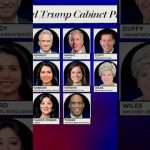In recent discussions regarding economic policies, President Trump’s strategic use of tariffs has come back into the spotlight. Unlike his predecessors, who might have viewed tariffs as a simple tool for raising revenue, Trump perceives them as a form of leverage—an instrument to negotiate with other nations. This approach ensures that while tariffs can provide a temporary advantage, they are not used recklessly to avoid triggering widespread inflation, a situation that no leader wants to face. This perspective on tariffs reveals a nuanced understanding of economics that deserves appreciation.
Donald Trump is known for his unique tactics that prioritize American interests. By employing tariffs selectively and strategically, he aims to foster better trade agreements rather than merely inflating prices for consumers. After all, a government that indiscriminately slaps on a 20% tariff across all imported goods might soon find itself grappling with the not-so-welcome label of “inflation president.” Such a strategy could hurt American families and consumers, as they would ultimately bear the brunt of higher prices. Instead, Trump’s approach is to use tariffs as a threat, a chess move that can force other nations to reconsider their positions.
Furthermore, the appointment of Scott Bessent as a key economic advisor has added a promising layer to Trump’s economic strategy. Renowned economist Steve Moore has expressed excitement about this pick, highlighting Bessent’s background as a supply-sider. This perspective symbolizes a commitment to policies that encourage growth rather than burdensome regulations. Supply-side economics advocates argue that lower taxes and less regulation spur productivity, leading to higher employment and wages. In essence, it’s about making it easier for businesses to thrive, which is something every American should rally behind.
The significance of such appointments cannot be overstated. Other than the Secretary of State, the role of Treasury Secretary is pivotal in shaping the country’s economic landscape. It is not merely a position but a platform to implement strategies that prioritize economic growth. A focus on economic revival and stability can pave the way for a more robust private sector, which is crucial for the nation’s overall prosperity. Ultimately, when businesses prosper, employees benefit, and the economy flourishes.
In conclusion, Trump’s strategic use of tariffs, paired with strong economic leadership, outlines a vision for America’s financial future that prioritizes growth and stability. For many on the right, this combination reflects a refreshing departure from excessive regulation and overreach. As long as there are leaders focused on making America friendly to business, the prospects for a thriving economy remain bright. And who knows—perhaps in the end, America will emerge as the champion of both economic prowess and consumer choice.




